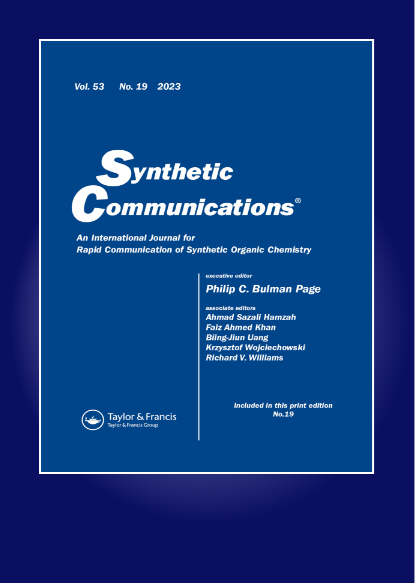多取代2-亚甲基-1,2-二氢吡啶的无溶剂催化合成
IF 1.8
3区 化学
Q3 CHEMISTRY, ORGANIC
引用次数: 0
摘要
在无催化剂和无溶剂的条件下,以3-甲酰基色酮、苯胺和脂肪族1,3-二酮为原料,通过一锅多组分反应合成了多取代2-亚甲基-1,2-二氢吡啶。反应通过席夫碱介导,迈克尔加成,开环/闭环的顺序过程进行,形成两个新的C-N键和一个C-C键。该工艺的优点是反应条件简单,产率高。本文章由计算机程序翻译,如有差异,请以英文原文为准。
A catalyst and solvent free synthesis of polysubstituted 2-methylene-1,2-dihydropyridines
Synthesis of polysubstituted 2-methylene-1,2-dihydropyridines were accomplished by one-pot multicomponent reaction of 3-formylchromones, anilines and aliphatic 1,3-diones under catalyst and solvent-free reaction conditions. The reaction proceeds via Schiff base mediated, Michael addition followed by ring opening/ring closure sequential process resulting two new C–N and one C–C bonds formation. Neat reaction conditions and higher yields are the advantages of the protocol.
求助全文
通过发布文献求助,成功后即可免费获取论文全文。
去求助
来源期刊

Synthetic Communications
化学-有机化学
CiteScore
4.40
自引率
4.80%
发文量
156
审稿时长
4.3 months
期刊介绍:
Synthetic Communications presents communications describing new methods, reagents, and other synthetic work pertaining to organic chemistry with sufficient experimental detail to permit reported reactions to be repeated by a chemist reasonably skilled in the art. In addition, the Journal features short, focused review articles discussing topics within its remit of synthetic organic chemistry.
 求助内容:
求助内容: 应助结果提醒方式:
应助结果提醒方式:


